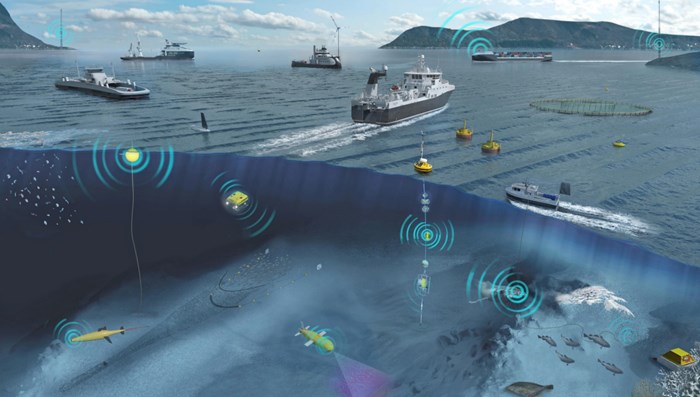The next steps in Møre Ocean Lab
At the beginning of December, we gathered over 40 experts in ÅKP's Blue Innovation arena to set the future course for the research infrastructure of Møre Ocean Lab. The meeting, which gathered professionals from both business and academic circles in the marine and maritime sectors, focused on a strong interdisciplinary collaboration where the goal was to identify and explore the unique opportunities Møre Ocean Lab offers and the needs that the infrastructure can cover.

Møre Ocean Lab is located outside Ålesund and is intended to be a full-scale test laboratory that marine and maritime research and industry can use. The groundbreaking project, led by NTNU Ålesund, is in close collaboration with recognized partners such as SINTEF, Runde Environmental Centre, and GCE Blue Maritime Cluster.
Møre Ocean Lab already consists of several significant initiatives. The most prominent is the "Digital Ocean Space" project, supported by the Research Council of Norway with an investment of NOK 30 million.
"This project helps to establish important infrastructure related to the Møre Ocean Lab," explains project manager and head of the department at NTNU, Hans Petter Hildre. "We have invested in a larger workboat, scheduled for delivery in 2024, which will be rigged for autonomous operation in the long term. In addition, we at NTNU in Ålesund are developing an advanced land-based control center for Møre Ocean Lab. This work also includes the installation of several measuring buoys and sensors in the surrounding ocean space."
Several other projects are also initiated under the umbrella of Møre Ocean Lab. Among other things, NTNU has filled the fish farm at Gudmundset with sensors, Runde Environmental Centre has several ongoing projects on marine monitoring, and SINTEF Ålesund is working on taking scaled experipents into full-scale trials. Møre Ocean Lab has also been designated as a test area for autonomous ships.
Furthermore, the "Fjordlab" project, part of the Norwegian Ocean Technology Centre in Trondheim, is in the planning phase. This project and several others will further expand Møre Ocean Lab's equipment, capacity and research horizon.
Existing infrastructure
Research and educational institutions are already benefiting from the infrastructure in place. An example of this is the Norwegian Public Roads Administration's (Statens vegvesen) measuring buoys in the Sula and Vartdalsfjord, which since 2016 have collected data that are openly available for use in research and innovation projects. Among other things, the sensors have been used to provide information about forces acting on passing ships. Runde Environmental Centre systematically analyses the data to better understand the fjord areas. Another example is the ferry quay at Magerholm, equipped with several sensors. This infrastructure already continuously collects valuable data.
A unique area and ecosystem
Møre Ocean Lab is geographically connected to the sea and fjord areas west of Ålesund. What makes this location so special is its unique topology and biodiversity. Few places in the world have such diversity spread over such a small area.
The area contains everything from deep, protected fjords to open, exposed coastlines within few kilometers. It houses several types unique natural landscapes containing essential habitats for juvenile fish and seabirds.
At the same time, the area is among the most plastic-polluted on the Norwegian coast, probably connected to the significant fishing industry in the region. High industrial activity in an area with rich biodiversity makes Møre Ocean Lab an ideal development arena for sustainable, green technology. Research and innovation can be crucial in preserving and restoring this unique ecosystem. New instrumentation and an even more comprehensive measurement program that provides continuous information on various parameters of the marine environment will make it possible to improve ocean and climate forecasting and to understand better the physical conditions that affect the survival and health of marine living resources, both wild and aquaculture.
More than a research center
In addition to being a very diverse ocean space, the area around Møre Ocean Lab also has something unique about it: One of the world's most complete and advanced ocean-oriented business clusters. Along Møre Ocean Lab, world-leading companies are close by, from equipment suppliers, ship designers, and shipyards to large fishing boat owners, fish processors, and modern fish farms.
By streamlining the process of testing new ideas, Møre Ocean Lab will accelerate the pace of innovation in the industry.
Kristian Steinsvik, Managing Director of SINTEF Ålesund
This makes Møre Ocean Lab a powerhouse for maritime innovation on an international scale. The interaction between the rich, natural surroundings and the dynamic business community creates a unique opportunity for interdisciplinary cooperation and development. The goal of this year's meeting was to inspire the business community to exploit the opportunities Møre Ocean Lab offers for groundbreaking initiatives in the years to come.
Kristian Steinsvik, Managing Director of SINTEF Ålesund and one of the leading partners in the Skaparkraft-funded mobilization project for Møre Ocean Lab", emphasizes this: "By streamlining the process of testing new ideas, Møre Ocean Lab will accelerate the pace of innovation in the industry." This underlines Møre Ocean Lab's role as a catalyst for future growth and development within the maritime industry.
Digitalization in focus
The day gave many innovative ideas for the future development of Møre Ocean Lab, with digitization as a key topic. It became clear that Møre Ocean Lab's role in the digital transformation is of great importance. Increased access to comprehensive, high-quality datasets will strengthen researchers' and industry's ability to gain deeper insights, promoting targeted research and product development.
NTNU in Ålesund recently launched its first civil engineering program in mechatronics and automation. Besides focusing on digital knowledge and the ocean, this program puts interdisciplinarity in focus.
We hope Møre Ocean Lab can become a playground for these students in the long term and that it will create collaborative arenas and interdisciplinary development that strengthen our world-leading maritime and marine clusters.